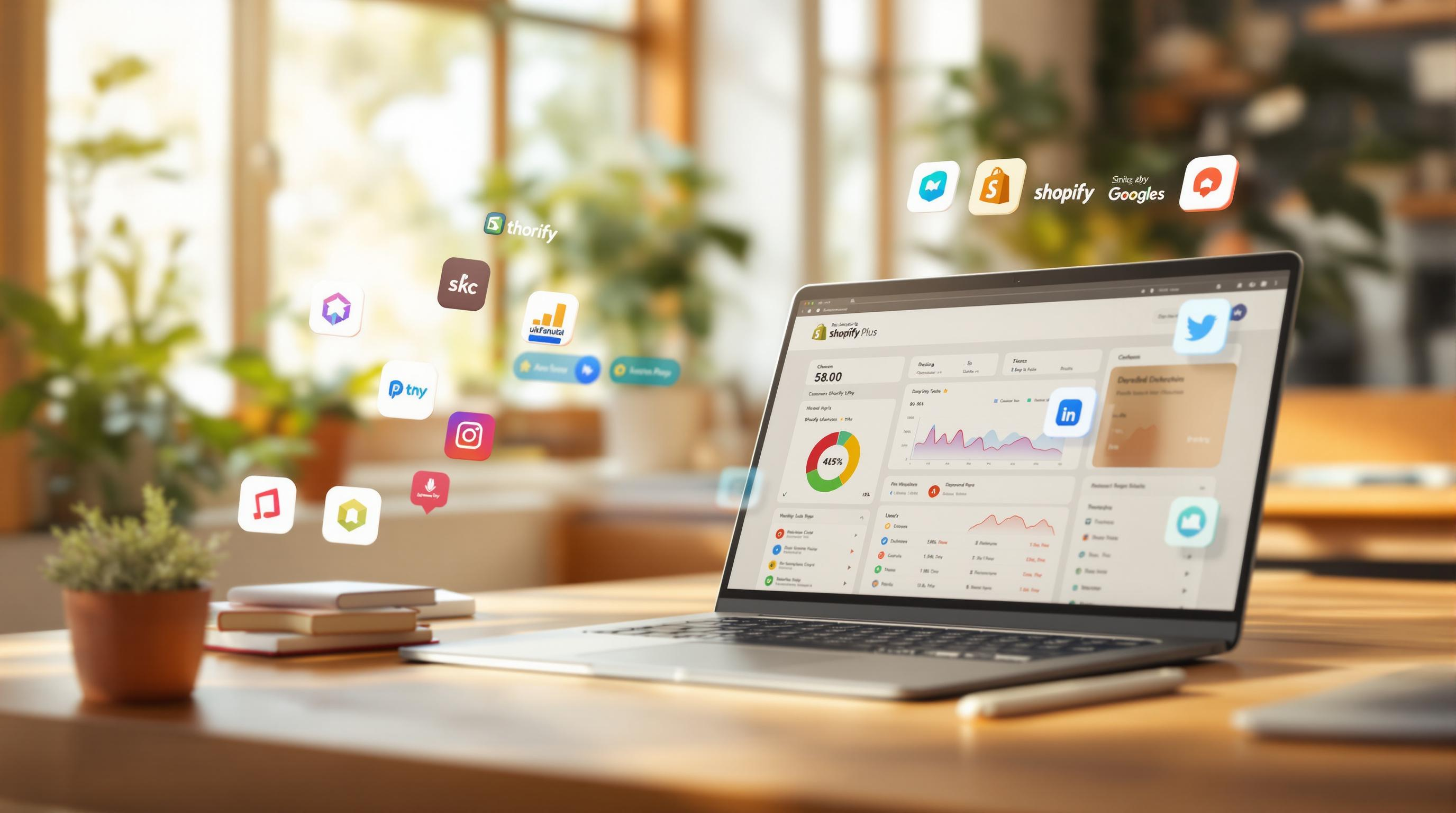By Mladen Terzic
Shopify Apps & Integrations
26th May 2025
6 min read
How to Sync Shopify Orders with ERP Systems
Discover the key steps to integrate Shopify with ERP systems, from choosing the right platform to maintaining a reliable data sync.

Syncing Shopify orders with an ERP system helps automate data flow, reduce manual errors, and manage inventory in real time. Here’s a quick breakdown:
- What It Does: Automatically syncs orders, inventory, customer data, and payments between Shopify and ERP.
- Why It Matters: Saves time, prevents overselling, and improves decision-making.
- How to Prepare:
- Identify business needs (order management, inventory, finances).
- Choose an ERP system that fits your size and goals (e.g., NetSuite, Microsoft Dynamics 365, SAP S/4HANA).
- Clean and organize your data (products, customers, and orders).
Integration Options:
- Shopify’s Built-In Tools: Use native ERP connectors for systems like Microsoft Dynamics or Oracle NetSuite.
- Custom Solutions: Build tailored integrations using Shopify’s API for complex workflows.
Steps to Integrate:
- Map data fields between Shopify and ERP.
- Set automation rules for updates.
- Test thoroughly before going live.
Maintenance Tips:
- Regularly update, audit, and monitor the system.
- Train your team to manage and troubleshoot integrations.
- Optimize performance as your business grows.
| ERP System | Key Features | Best For |
|---|---|---|
| NetSuite | Real-time sync | Mid to large enterprises |
| Microsoft Dynamics 365 | Shopify connector | Growing businesses |
| SAP S/4HANA | Cloud scalability | Large enterprises |
Integrating Shopify with an ERP streamlines operations, reduces errors, and supports business growth. Start by evaluating your needs and choosing the right solution for your goals.
Integrating Shopify Orders with SAP Business One

Getting Ready to Connect Shopify with ERP
Identifying Business Needs
Before starting the integration process, it’s important to clearly understand what your business needs. Take a close look at your current challenges and where you plan to grow. Pay attention to these areas:
- Order Management: Look at your order volumes, including busy seasons and expected growth.
- Inventory Control: Review how you manage SKUs across different sales channels and warehouses.
- Financial Requirements: Pinpoint the financial data you need to sync, such as transactions and accounting details.
Once you’ve mapped out these needs, the next step is to choose an ERP system that fits your business.
Selecting the Right ERP System
Picking the right ERP system can make or break your Shopify integration. Many ERP solutions come with built-in Shopify connectors. Here are a few options:
| ERP System | Key Features | Best Suited For |
|---|---|---|
| NetSuite | Real-time sync | Mid to large enterprises |
| Microsoft Dynamics 365 | Shopify connector | Growing businesses |
| SAP S/4HANA | Cloud scalability | Large enterprises |
When comparing ERP systems, focus on these factors:
- Integration Capabilities: Choose a system with proven Shopify integration options.
- Scalability: Make sure it can support your growth plans.
- Total Cost: Factor in setup, training, and ongoing maintenance expenses.
Organizing and Cleaning Data
Clean, well-organized data is key to a smooth integration. Start by auditing the data in both Shopify and your ERP system. Here’s what to focus on:
Product Data:
- Standardize product names, SKUs, and pricing.
- Update inventory levels.
Customer Information:
- Remove duplicate entries and format addresses consistently.
- Verify contact details.
Order History:
- Check order statuses and transaction records.
- Ensure payment information is formatted correctly.
Using data mapping tools can help align Shopify and ERP formats. If your data is especially complex, working with integration specialists may be a smart move to streamline the process.
Once your data is cleaned and standardized, you’ll be ready to dive into syncing Shopify orders with your ERP system.
sbb-itb-6dc743d
Ways to Sync Shopify Orders with ERP Systems
Using Shopify's Built-In Integrations
Shopify offers native integrations with several ERP platforms, making it easier to sync orders and manage data without extensive setup or configuration:
| ERP System | Key Integration Features | Best For |
|---|---|---|
| Microsoft Dynamics 365 | Syncs orders and updates inventory in real-time | Mid-sized retailers |
| Oracle NetSuite | Directly maps data fields and reconciles financial transactions | Enterprise businesses |
| Brightpearl | Automates order processing and syncs data across multiple sales channels | Omnichannel retailers |
The Import & Export Tool for Shopify is another option, allowing you to automate routine synchronization tasks and ensure data consistency across platforms.
Creating Custom Integration Solutions
For businesses with more complex workflows or specific needs, custom integrations are often the better choice. These solutions are built using Shopify's API and can handle unique workflows, multi-channel operations, or advanced reporting requirements.
Agencies like Codersy specialize in creating tailored Shopify-ERP integrations that meet specific challenges while ensuring scalability and reliability.
Steps for Setting Up Integration
-
Configure Data Mapping
- Match order fields and inventory rules between Shopify and your ERP system.
- Define how data will transfer between platforms.
-
Implement Automation Rules
- Set triggers for updating order statuses.
- Enable inventory alerts and automate financial data transfers.
-
Test and Validate
- Test the accuracy of order and inventory synchronization.
- Confirm that financial transactions are correctly matched.
Shopify provides built-in testing tools to help verify the integration. Regular monitoring and maintenance are essential to keep everything running smoothly and to catch any potential issues early.
Keeping and Improving the Integration
Testing and Training Your Team
Start by testing how well your system handles data synchronization, inventory updates, and order status tracking under everyday business conditions. Make sure designated team members are trained to oversee synchronization, resolve issues, and help onboard others. Document these processes to ensure consistency.
Build a knowledge base that includes step-by-step procedures, troubleshooting tips, and best practices. This shared resource ensures your team can work efficiently without relying too heavily on specific individuals.
Once testing shows everything is running smoothly and your team is confident in their roles, shift your focus to maintaining and fine-tuning the integration for long-term success.
Updating and Maintaining the System
Keeping your system in top shape requires regular upkeep. Stick to this simple schedule:
| Task | Frequency | Focus Areas |
|---|---|---|
| Updates | Monthly | Security and compatibility |
| Audits | Weekly | Data accuracy |
| Monitoring | Daily | Performance metrics |
| Backups | Weekly | Recovery readiness |
Keep an eye on data transfer speeds, error rates, and system performance, especially during peak business hours. Once the integration is stable, you can shift your attention to scaling and optimizing its performance.
Scaling and Improving Performance
As your business grows, prioritize these areas:
- Process Optimization: Speed up data handling by batching transfers, automating alerts, and scheduling tasks during quieter times.
- Performance Tweaks: Regularly review system metrics to spot bottlenecks. If needed, upgrade hardware or implement load balancing to handle increased demand.
"Regular system audits and performance monitoring are crucial for maintaining a healthy integration. We've seen clients achieve up to 40% faster order processing times simply by optimizing their data synchronization schedules and implementing proper caching mechanisms", says a senior developer at Codersy, emphasizing the value of staying proactive [2].
Summary and Next Steps
Why Connect Shopify with ERP?
Integrating Shopify with an ERP system can simplify your operations. It helps reduce stock-related problems, minimizes manual errors, and boosts both efficiency and customer satisfaction [1]. By syncing data between platforms, businesses can process information faster and make smarter decisions [2].
| Key Outcome | Impact |
|---|---|
| Unified Operations | Smoother workflows |
| Better Reporting | Smarter decision-making |
| Automated Tasks | Fewer manual processes |
Now that the benefits are clear, let’s look at how to take the next steps in your integration process.
Steps to Take Before Integration
Before diving into integration, take a close look at your current setup. Evaluate factors like your order volume, inventory complexity, and the systems you already use [2][3]. Whether you choose Shopify's Global ERP Program or decide to build a custom solution, make sure your choice aligns with your long-term goals [3].
For businesses with specific or complex needs, custom ERP solutions can offer the flexibility and scalability required to grow effectively [2]. As your business expands, these tailored integrations can keep up with your needs while maintaining smooth operations.
"The success of an ERP integration largely depends on proper planning and choosing the right solution for your specific business needs. We've observed that businesses who take time to evaluate their requirements typically achieve full ROI within 6-8 months of implementation", says a senior developer at Codersy, emphasizing the value of strategic preparation [2].



